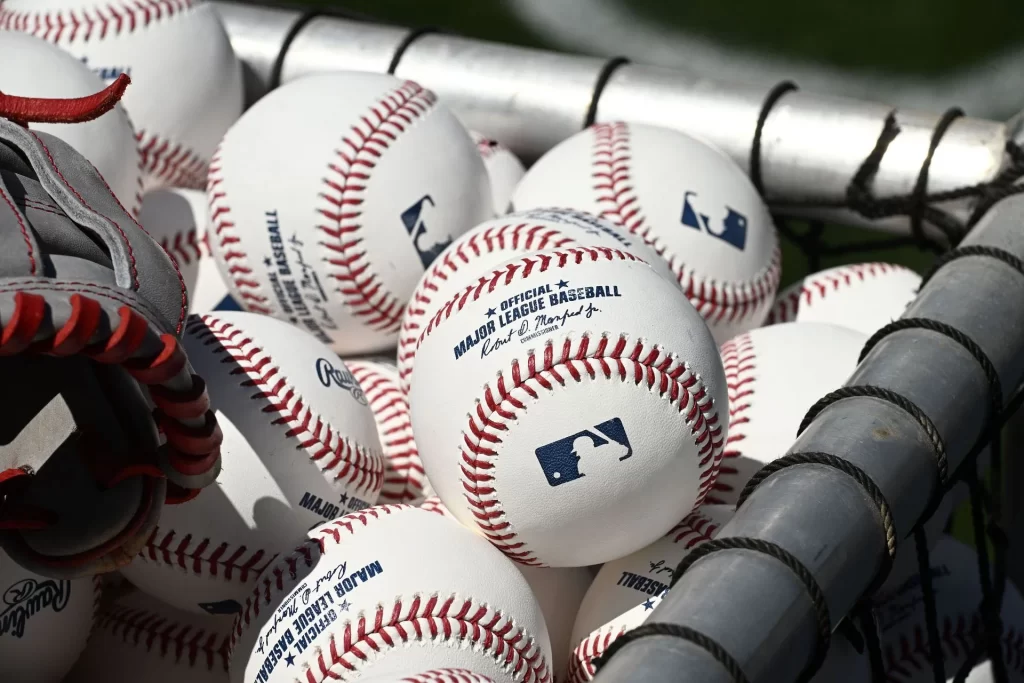The Anatomy of an MLB Baseball: Understanding the Seams
Introduction
The official baseball of Major League Baseball (MLB) is a meticulously crafted object, rich in history and detail. One of the most intriguing aspects of the baseball is its stitching, often referred to as the seam. This article delves into the specifics of how many seams are on an MLB baseball, the history behind the stitching, and the production process of these iconic balls.
The Production Process
The creation of an MLB baseball involves several steps, starting from the core to the final stitching. Here is a brief overview:
- Core: The process begins with a four-inch wide cork sphere, which serves as the core of the baseball.
- Wrapping: The cork core is then wrapped with layers of rubber and yarn to achieve the desired size and weight.
- Leather Covers: The ball is then fitted with leather covers, which are cut from hides processed in Pennsylvania and tanned in Tennessee.
- Stitching: The leather covers are sewn together by hand, using 108 double-stitches of waxed red thread. This stitching is what forms the seam of the baseball.
- Finishing Touches: After stitching, the baseballs are stamped with the MLB logo and the commissioner’s signature. They are also coated with mud collected from the New Jersey bank of the Delaware River to improve grip.
The Seam
Despite having over 100 stitches, an MLB baseball technically has only one seam. This seam waves its way around the circumference of the ball. The terms “two-seam” and “four-seam” fastballs refer to the appearance of the seams to the batter when the pitch is thrown, not the actual number of seams on the ball.
The History Behind the Seam
The design and construction of the baseball, including its seam, have evolved over time. Here is a brief historical overview:
Early Beginnings
In the mid-19th century, baseballs were not standardized. They varied in size, weight, and material. The first official rules for baseball, established in 1857, did not specify the exact dimensions or construction of the ball. It wasn’t until the late 1800s that the modern baseball began to take shape.
The Introduction of the Cork Center
In 1925, the cork center was introduced to replace the rubber core. This change significantly improved the ball’s performance and consistency. The cork center provided a more stable and predictable bounce, which was crucial for the game’s integrity.
Standardization
By the early 20th century, Major League Baseball had standardized the dimensions and construction of the baseball. The official rules specified that the ball must weigh between 5 and 5.25 ounces and measure between 9 and 9.25 inches in circumference. The stitching, which forms the seam, was also standardized to ensure consistency across all balls.
The Role of Rawlings
Rawlings, the official manufacturer of MLB baseballs since 1977, has played a significant role in maintaining the quality and consistency of the balls. Rawlings produces approximately 2.4 million baseballs each year, adhering strictly to MLB’s specifications.
The Significance of the Seam
The seam on a baseball is more than just a structural element; it plays a critical role in the game itself.
Pitching
The seam is crucial for pitchers, as it affects the aerodynamics of the ball in flight. Different types of pitches, such as the two-seam fastball and the four-seam fastball, rely on the orientation and movement of the seam relative to the direction of the pitch. The two-seam fastball, for example, is thrown with the seams aligned in a way that creates a sinking motion, while the four-seam fastball has the seams perpendicular to the direction of the pitch, resulting in a straighter trajectory.
Batting
For batters, the visibility of the seam is essential. The red stitching against the white leather background helps batters track the ball as it approaches the plate. This visibility is particularly important at high speeds, where fractions of a second can make the difference between a hit and a miss.
Table: Key Facts About MLB Baseballs
| Fact | Description |
|---|---|
| Number of Stitches | 108 double-stitches of waxed red thread |
| Number of Seams | 1 seam that waves around the circumference |
| Material | Leather covers from hides processed in Pennsylvania and tanned in Tennessee |
| Production Location | Rawlings in Turrialba, Costa Rica |
| Annual Production | Approximately 2.4 million baseballs per year |
| Mud Coating | Mud collected from the New Jersey bank of the Delaware River |
FAQ Section
Q: How many seams are on an MLB baseball?
A: There is only one seam on an MLB baseball, which waves its way around the circumference of the ball.
Q: Why are the stitches on a baseball red?
A: The stitches are red because it is the most highly visible color, which helps batters see the ball better as it approaches. This standard was adopted league-wide in 1934.
Q: Where are MLB baseballs produced?
A: MLB baseballs are produced by Rawlings in Turrialba, Costa Rica.
Q: What is the significance of the mud coating on baseballs?
A: The mud coating, collected from the New Jersey bank of the Delaware River, improves the grip of the baseball for pitchers.
Q: How many baseballs are produced each year?
A: Approximately 2.4 million baseballs are produced each year from about 20,000 hides.
Conclusion
The MLB baseball, with its intricate stitching and precise production process, is a testament to the attention to detail and tradition in American sports. Understanding the anatomy of the baseball, particularly the seam, provides a deeper appreciation for the game and its history.For further information, you can refer to the official guidelines and historical data available through reputable sources such as the MLB or sports history websites.



